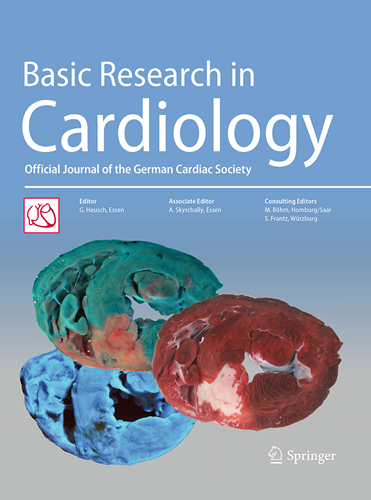心血管疾病中蛋白质稳态的改变与阿尔茨海默病样神经病理学有关。
IF 8
1区 医学
Q1 CARDIAC & CARDIOVASCULAR SYSTEMS
引用次数: 0
摘要
心血管疾病(cvd)是世界范围内死亡的主要原因。众所周知,心血管疾病会增加随后神经退行性变的风险,但其机制和涉及的蛋白质尚未阐明。我们之前的研究表明,在小鼠中诱导的心肌梗死(MI)与假MI小鼠相比,会导致心脏和大脑中蛋白质聚集、内质网(ER)应激的增加,以及蛋白质抑制途径的变化。在这项研究中,我们进一步研究了小鼠诱导心肌梗死改变的分子机制,这也与阿尔茨海默病(AD)和心血管疾病(CVD)患者死后人类海马聚集体的蛋白质组学与年龄匹配对照(AMC)有关。我们利用聚集体内交联来识别蛋白质之间的接触或接近,从而重建聚集体的“接触组”(非功能相互作用组)。我们使用留一分析(LOOA)来确定每种蛋白质对总体聚集体内聚的贡献,并对组成蛋白质进行基因本体荟萃分析,以定义区分AD和/或CVD与AMC聚集体的关键细胞器、过程和途径。我们在AD和CVD聚集物中发现了有影响的蛋白质,其中许多与先前涉及神经退行性变的途径或过程相关,如线粒体、氧化和内质网应激;蛋白质聚集和蛋白质静止;泛素蛋白酶体系统与自噬;轴突运输;和突触。本文章由计算机程序翻译,如有差异,请以英文原文为准。
Altered protein homeostasis in cardiovascular diseases contributes to Alzheimer's-like neuropathology.
Cardiovascular diseases (CVDs) are the leading cause of death worldwide. CVD is known to increase the risk of subsequent neurodegeneration but the mechanism(s) and proteins involved have yet to be elucidated. We previously showed that myocardial infarction (MI), induced in mice and compared to sham-MI mice, leads to increases in protein aggregation, endoplasmic reticulum (ER) stress in both heart and brain, and changes in proteostatic pathways. In this study, we further investigate the molecular mechanisms altered by induced MI in mice, which were also implicated by proteomics of postmortem human hippocampal aggregates from Alzheimer's disease (AD) and cardiovascular disease (CVD) patients, vs. age-matched controls (AMC). We utilized intra-aggregate crosslinking to identify protein-protein contacts or proximities, and thus to reconstruct aggregate "contactomes" (nonfunctional interactomes). We used leave-one-out analysis (LOOA) to determine the contribution of each protein to overall aggregate cohesion, and gene ontology meta-analyses of constituent proteins to define critical organelles, processes, and pathways that distinguish AD and/or CVD from AMC aggregates. We identified influential proteins in both AD and CVD aggregates, many of which are associated with pathways or processes previously implicated in neurodegeneration such as mitochondrial, oxidative, and endoplasmic-reticulum stress; protein aggregation and proteostasis; the ubiquitin proteasome system and autophagy; axonal transport; and synapses.
求助全文
通过发布文献求助,成功后即可免费获取论文全文。
去求助
来源期刊

Basic Research in Cardiology
医学-心血管系统
CiteScore
16.30
自引率
5.30%
发文量
54
审稿时长
6-12 weeks
期刊介绍:
Basic Research in Cardiology is an international journal for cardiovascular research. It provides a forum for original and review articles related to experimental cardiology that meet its stringent scientific standards.
Basic Research in Cardiology regularly receives articles from the fields of
- Molecular and Cellular Biology
- Biochemistry
- Biophysics
- Pharmacology
- Physiology and Pathology
- Clinical Cardiology
 求助内容:
求助内容: 应助结果提醒方式:
应助结果提醒方式:


